 |
|
 |
|
updated to follow: Stratigraphic Guide to the Cromer Knoll, Shetland and Chalk Groups of the North Sea and Norwegian Sea. Felix M. Gradstein & Colin C. Waters (editors), Mike Charnock, Dirk Munsterman, Michelle Hollerbach, Harald Brunstad, Øyvind Hammer & Luis Vergara (contributors). Newsletter on Stratigraphy, vol 49/1 pp71-280, 2016
Shetland Group, Nise FormationThe Nebbhval Member is a local member of the Nise Formation characterised by sandstones and interbedded mudstones developed in the south-western part of the Vestfjorden Basin.
Timing suggests that the Nebbhval Member is related to the same tectonic episode that introduced the thick Spekkhogger Member sandstones into the deeper Vøring Basin. This has been attributed to the initial phase of Campanian-Paleocene rifting that led to the continental separation between the North Atlantic and the Norwegian Sea.
Whereas the sandstones of the Spekkhogger Member are considered to have been derived from the north or northeast, the sandstones of the Nebbhval Member are probably derived from the Norwegian mainland. The Nebbhval sands have been assigned to Zone NCF16, dated as Late Cretaceous, earliest Campanian age
Derivatio nominis: Nebbhval is the Norwegian name for the northern bottlenose whale species Hyperooden ampullatus. This is a toothed whale up to 10m size that can be found in increasing numbers in the deeper water areas of the Norwegian Sea around Iceland and Jan Mayen in addition to west of Svalbard and in the North Atlantic.
The sandstones are light olive grey to olive grey, clear to transparent or translucent quartz grains, fine to medium, occasionally medium or coarse to very coarse in places, moderately sorted, angular to sub-rounded, white to light grey matrix, moderate calcareous cement, friable to moderately hard, occasionally micaceous with common glauconite.
The mudstones are medium dark grey to olive grey, predominantly firm, moderately hard, sub-fissile to blocky, micro-micaceous, micro-pyritic, slightly or moderately calcareous and sandy or silty in parts.
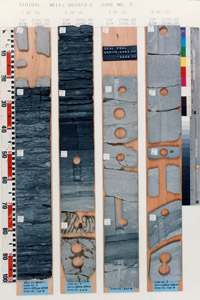 6610/3-1, 2292-2296 m |
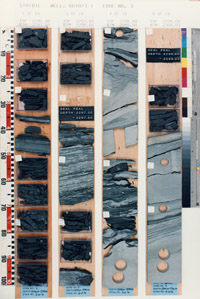 6610/3-1, 2296-2300 m |
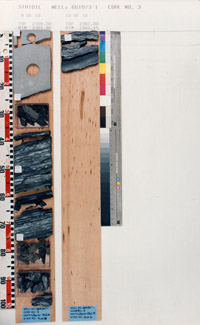 6610/3-1, 2300-2301 m |
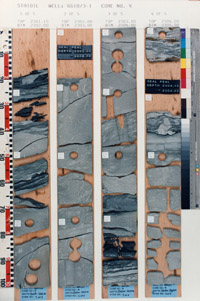 6610/3-1, 2301-2305 m |
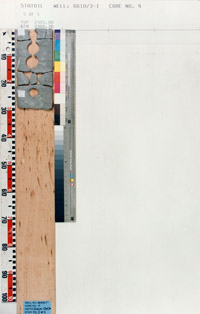 6610/3-1, 2305-2306 m |
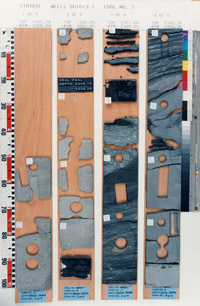 6610/3-1, 2305-2309 m |
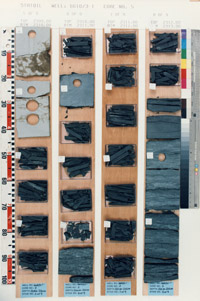 6610/3-1, 2309-2313 m |
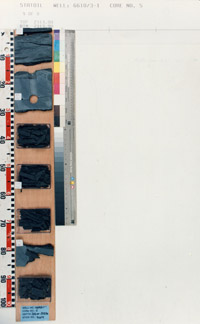 6610/3-1, 2313-2313 m |
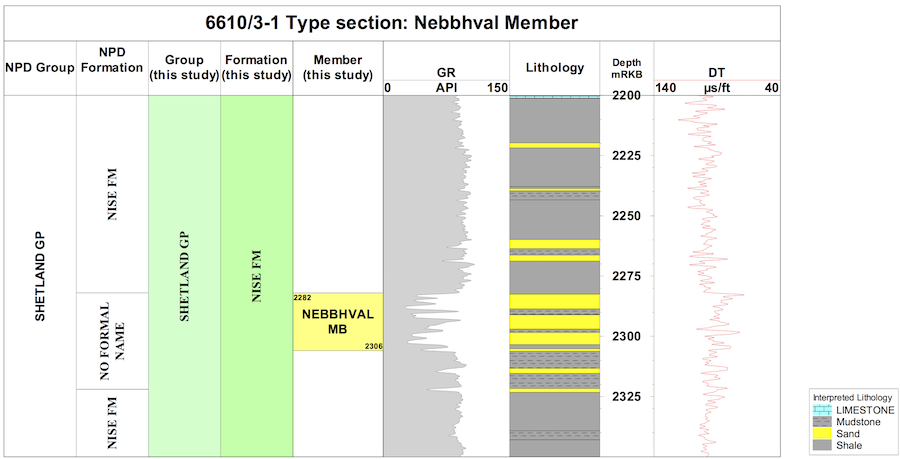
Click for large version (PDF)
Deeper in the section is the LO Valensiella reticulata. Within this member is an influx of Chatangiella bondarenkoi that may be useful for local correlation.
The Nebbhval Member is a time equivalent of the oldest part of the Spekkhogger Member developed in the Vøring Basin and part of the K85-K90 sequence of Vergara et al. (2001) and K70 sequence of Færseth and Lien (2002) and Lien (2005). These sandstones were probably generated during the same Campanian rifting event associated with the Spekkhogger Member although they have a different source direction towards the Norwegian mainland.
The microfaunas, recovered from cores in the type section 6610/3-1 within this member, are dominated by abundant, simple, tubular, agglutinated foraminifera e.g. Rhabdammina spp. This suggests a deep water, bathyal palaeoenvironment and bottom conditions with lower oxygen.
Lien, T. 2005. From Rifting to drifting: effects on the development of deep-water hydrocarbon reservoirs in a passive margin setting, Norwegian Sea. Norwegian Journal of Geology, 85, 319-332.
Vergara, L., Wreglesworth, I., Trayfoot, M., Richardsen, G. 2001. The distribution of
Cretaceous and Paleocene deep-water reservoirs in the Norwegian Sea basins.
Petroleum Geoscience, 7, 395-408.
| home | previous page |